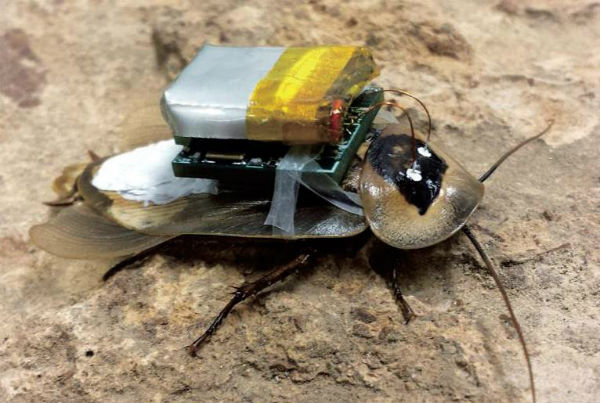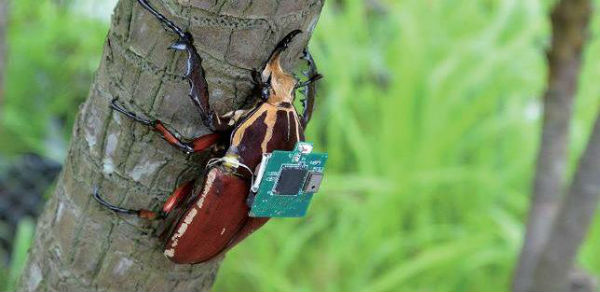What is your first reaction when thinking of bugs? Many people describe bugs as vile creatures that lurk around for no good reason, when they actually have many valuable skills and purposes. Contradicting with the previous statement, however, would a person’s first reaction remain the same if these bugs were to be controlled in all circumstances? As we are all aware, modern society never ceases to innovate and develop products that once seemed impossible in the eyes of our ancestors. Scientists, using modern technology, have successfully created robots using living bugs, which permits full control over these bugs’ actions. The Sungkyun Times (SKT) scrutinizes the concept and potential impact of these creatures and analyzes the limitations and prospects of this new development.
What Are Cyborg Bugs?
Concept
The concrete definition of cyborg bugs has yet to be coined because of its prototypical nature, but it simply refers to real life bugs that have been surgically modified with technology placed inside of their bodies in order to control their every action just as if they were cyborgs. A cyborg, according to Free Dictionary, is “an organism, often a human, that has certain physiological processes enhanced or controlled by mechanical or electronic devices, especially when they are integrated with the nervous system.” Cyborg bugs, however, are not to be confused with nanobots, which are robots designed and programmed in the shape of bugs with enhanced abilities to aid their progress. Cyborg bugs emphasize implanting electrodes into real living biological bugs taken from nature in order to control their movements and actions. The controlling of these bugs is achieved by stimulating electrodes within their muscles, nerves, or brain using electrical currents or radio signals. Currently, cyborg bug projects have been pushed by government agencies such as the Defense Advanced Research Projects Agency (DARPA) in the United States for military and surveillance purposes, but this still remains classified information.
Specifications
As mentioned above, many people still have perplexities in understanding the concept of robots versus cyborg bugs. Delving in, cyborg bugs are biological living creatures. This means that these bugs are nature-born into the world and therefore come with premade body parts and their own instinctive minds that are needed for survival. Robots, on the other hand, must be artificially created and specifically programmed and designed to carry out a certain function. The interesting point here is that the use of electrodes connected to the bodies of cyborg bugs grants complete authority and control over these bugs’ movement. These cyborg bugs, therefore, connected with mechanical equipment, are able to take on wider ranges of work and end up possessing abilities that are above their own capabilities. Advantageously, the implementation of cyborg bugs takes less energy and cost compared to the creation of robots such as drones, artificial intelligence, and other technological advancements.
Application of Cyborg Bugs
Rescue

Generally speaking, all cyborg bugs are fairly miniscule, allowing for easy maneuvering that can be used where these bugs can reach places that humans cannot have access to, such as the rubble in the aftermath of an earthquake. Furthermore, bugs are very sensitive to vibrations and noise, making them much more reliable to locate survivors in need of rescuing. Moreover, bugs are instinctively hardwired in a way that enables them to sense approaching natural disasters, making these cyborg bugs useful in detecting future natural catastrophes. The most appropriate example of a cyborg bug in this field is the cyborg cockroach. Due to its flying and regenerative abilities, cyborg roaches are less likely to die and can be progressively used to find survivors in a rescue mission. These cyborg roaches have electrodes implanted in their antennas, giving control over their movements by stimulating them to the desired direction using a wireless circuit board. The circuit board also has a camera and sensor installed for better guidance. Cyborg roaches have currently worked through live simulations pertaining to earthquakes and should be able to partake in rescue missions in the near future.
Surveillance

Cyborg bugs can act in the field of surveillance because they are very small and unnoticeable, and due to their high performance, they are seen as a possible replacement for drones. This specific area has been heavily advocated by the government for informational reasons relying on surveillance. Cyborg moths are the most satisfactory example of cyborg bugs in this field. Led by engineers at North Carolina State University, Cornell, and MIT, the cyborg moth project began. When making a cyborg moth, a scientist implants electrodes on the lower abdominal half of the moth during the larval stage. As the moth fully matures, the electrodes become securely intact, procuring full access of movements through the circuit board, which also has a camera to record. A cyber moth was apparently used in a conflict between Israel and Palestine dealing with potential terrorist suspicions, and the cyborg moth helped gather needed information.
Experiment and Research

Cyborg bugs are exceptional in this field because they are instinctive creatures from the beginning. Bugs in general have their own personal way of life, and by observing and modifying the behaviors of these cyborg bugs, the results may lead to natural evolution. Natural evolution pertains to the idea of teaching these bugs how to overcome obstacles by repeatedly controlling their movements to teach them a certain task. The cyborg beetle portrays an outsanding example. Led by Nanyang Technological University in Singapore and the University of California at Berkley, scientists have implanted electrodes in a beetle’s brain, antenna, legs, optic lobes, and flight muscles, allocating for the full access of movement by using radio signals to contract nerves within its body. Through access of movements, these scientists repeatedly controlled motion and taught the beetle how to overcome its limitations such as searching for food in latent areas. Such tasks were completed by taking the cyborg beetle to secluded areas where its food could be found, and eventually, the bug attained this skill of searching for nearby similar indications of new food settings.
Obstacles and Future Prospects
Technical Problems
The first and foremost technical issue when dealing with cyborg bugs is that they have a limited life supply. As biological creatures, these bugs only live for short periods and therefore can take in only limited amounts of improvement before the host bug dies, and then researchers have to start the process over with a new cyborg bug. The particularly small body of the bug is another technical issue because if the electrodes become implanted in the wrong area, it ends up paralyzing or killing the bug. Lastly, because bugs can only hold up to a certain weight, scientists must be very careful in applying only a certain amount of equipment.
Ethical Conflicts
There have been many debates over the controversy of ethical duality with cyborg bugs. First, the action of forcibly controlling, anesthetizing, and moving the bugs away from their instinctive actions has raised many questions about the continuity of this project. Furthermore, the action of straying away from nature’s law and artificially permitting these cyborg bugs to go through evolution is seen as a moral dispute by many people. Lastly, the societal issues over the actual spread and invasive boundaries have raised many arguments, many of which have expressed a desire to discontinue the cyborg project.
Prospects
Despite the many limitations and issues that cyborg bugs are facing, they can be seen with great prospects for the future. Through their applications and research, these bugs may be able to act as a warning guide for natural disasters and even aid in getting rid of environmental issues by observing the ecosystem. Moreover, there are hopes to move further applicable cyborg technology to animals or even to humans to be able to achieve a greater ability than that of our own limited capacity.
There is no doubt in saying that these bugs have opened up a new perspective toward new implementations that are to come. With regard to ethical and moral issues, however, the cyborg bugs model should also take caution when exploring the boundaries between research and violating life forces. Although cyborg bugs still have many obstacles to overcome before fitting into society, the SKT hopes that this article was able to portray an alternative view of bugs as a necessity in our lives and illustrate an innovative technical adaption of the future of tomorrow, today.
